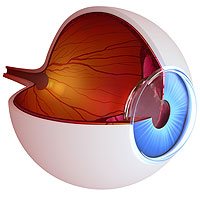
Your eyes contain many different parts that work together to create sight. There are the corneas that focus a large part of the light that enters the eyes.
The pupils contract and relax to control the amount of light entering the eyes. The lens moves and adjusts inside of the eye to focus the light the rest of the way, and these are only a few of the many parts of the eye. Keep reading to learn more about the retina and how it works!
What Is The Retina?
One of the most important parts, if not the most important part, of the eyes, is the retina. The retina is what the rest of the eye is working towards focusing light onto.
It’s located inside of the eye on the back wall and made of millions of microscopic light-sensitive cells. These cells come in two varieties: rods and cones. Both types of cells are vital to normal, healthy vision.
How Do Rods And Cones In The Retina Work?
Rods are cylindrical in shape and are responsible for sight in situations with low light. There are about 120 million rods in a healthy adult’s retina, and they are scattered all around the retina in a ring.
Cones are focused in the center of the retina and usually only add up to 7 million in number. These cone-shaped cells don’t function well in low light but are necessary to detect color.
They come in three subvarieties based on what wavelength of light they detect: short, medium, or long.
Retinal Problems
Since the retina is a sensitive piece of tissue, it is also extremely fragile. There are many different problems that can face anyone’s retina, which is a good reason to come in for an appointment.
Having regular eye appointments at Eye Care Specialists will allow your doctor to test for and treat some of the following retinal problems you may encounter. Some common retinal problems include:
Macular Degeneration
Macular degeneration is an incurable eye condition that affects more than 10 million Americans. Macular degeneration is one of the leading causes of blindness.
It occurs when the central part of the retina (which holds all the cones) begins to deteriorate. This rapidly destroys central vision, causing a rift to open up in your vision.
While there is no way to reverse macular degeneration, you can slow its progression by leading a healthy lifestyle.
Diabetic Retinopathy
Diabetic retinopathy is a problem in which the retina begins to bleed due to high blood sugar. The blood vessels inside the eye are very delicate.
When your blood sugar is too high, the vessels can become blocked and blood flow can become cut off. This causes the vessels to swell and leak.
While there are very few symptoms of diabetic retinopathy at first, it can lead to blindness if left untreated.
Retinal Detachment
Retinal detachment occurs when the retina begins to peel off of the inside wall of the eye. This can be as the result of blunt force trauma, unchecked retinal diseases such as diabetic retinopathy, or something else.
Keeping your retina healthy and strong is necessary for a stable vision. Concerned about retinal problems? Schedule an appointment at Eye Care Specialists in Bloomsburg, PA now!

















